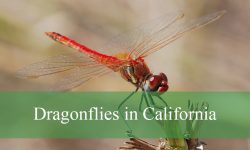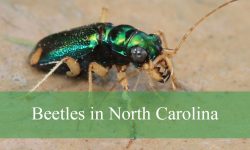For anyone who loves birdwatching, few sights are as thrilling as spotting vibrant red birds in Maryland. Their brilliant plumage adds a splash of color to forests, parks, and even urban backyards, making every birding outing feel special. As someone passionate about observing these stunning creatures, I find that Red Birds in Maryland offer some of the most rewarding and unforgettable experiences.
Red Birds in Maryland are not only beautiful but also diverse, ranging from the familiar Northern Cardinal to striking woodpeckers and tanagers. Each species has its own unique behaviors, songs, and habitats, which makes learning about them all the more fascinating. Whether you’re a seasoned birder or just starting out, knowing how to identify these fiery feathered friends will deepen your appreciation of Maryland’s rich birdlife.
In this guide, we’ll explore seven of the most captivating red birds you can encounter in Maryland, complete with identification tips and interesting facts. Get ready to discover their vibrant colors, distinctive calls, and the best places to find them throughout the state. Let’s dive into the world of Maryland’s most dazzling red birds!
Common Red Birds Found in Maryland
Northern Cardinal (Cardinalis cardinalis)
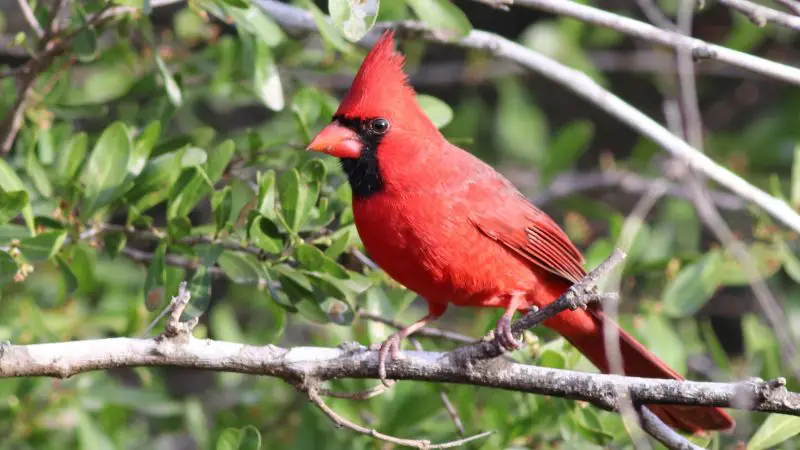
The Northern Cardinal is easily one of the most recognizable birds in Maryland due to its striking appearance and vivid coloration. Males display a brilliant red plumage from head to tail, highlighted by a distinctive black mask around the eyes and extending to the throat. Their crest, a pointed tuft of feathers on top of the head, adds to their bold silhouette. Females are more muted, showing warm tan and brown tones with soft reddish highlights on the wings, tail, and crest, making them less conspicuous but equally charming.
In terms of size, Northern Cardinals measure about 8 to 9 inches (20 to 23 cm) in length, with a wingspan of approximately 10 to 12 inches (25 to 31 cm). Their heavy, cone-shaped beaks are perfect for cracking seeds, which is a staple of their diet. Cardinals are also known for their rich, melodic songs that include a series of clear whistles. Both males and females sing, often to defend territory or communicate.
Behaviorally, Northern Cardinals are primarily non-migratory and remain in Maryland throughout the year. They are often seen at feeders, especially during winter when natural food sources are scarce. Cardinals are territorial birds, frequently chasing off rivals to maintain their space. Their diet consists mainly of seeds, fruits, and insects, and they forage on or near the ground as well as in shrubs and trees.
Northern Cardinals inhabit a variety of habitats in Maryland, including woodlands, gardens, shrublands, and suburban backyards. Their adaptability to human environments makes them a common sight in many parts of the state. You can find them from urban parks to rural forest edges, and they tend to be most visible during the early morning and late afternoon hours.
Scarlet Tanager (Piranga olivacea)
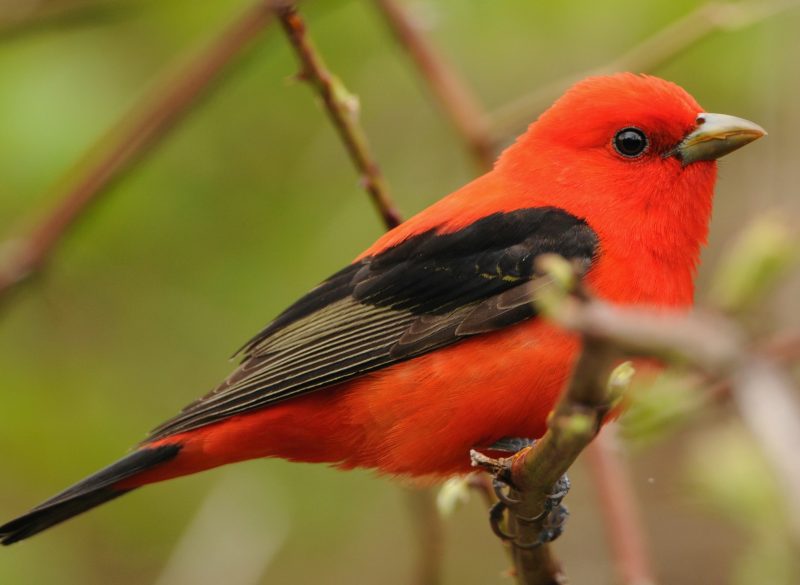
The Scarlet Tanager is a spectacular sight in Maryland during the breeding season. Male Scarlet Tanagers boast brilliant scarlet-red bodies contrasted sharply by jet-black wings and tail feathers. This striking coloration makes them stand out vividly against the lush green of deciduous forests. Females, on the other hand, exhibit a more subdued yellowish-olive color that provides excellent camouflage among the foliage, helping them remain hidden from predators.
This medium-sized songbird measures about 7 to 8 inches (18 to 20 cm) in length with a wingspan around 12 inches (30 cm). Their song is a distinctive, burry warble often described as a robin-like “chip-burr” sound repeated several times. The males sing to attract mates and defend their territories during the breeding season. Outside of breeding, Scarlet Tanagers tend to be quieter and more secretive.
Scarlet Tanagers are primarily insectivorous, feeding on a diet of caterpillars, beetles, ants, and other arthropods. They also supplement their diet with fruits and berries when insects are less abundant. These birds forage high in the tree canopy, skillfully gleaning insects from leaves and branches while avoiding detection.
In Maryland, Scarlet Tanagers arrive in late spring to breed, preferring mature deciduous forests with a closed canopy. They are most commonly found in large forested areas such as state parks and nature reserves. By late summer and early fall, they migrate to their wintering grounds in South America. Birdwatchers in Maryland often seek Scarlet Tanagers during May through July when their vibrant colors are most visible.
Summer Tanager (Piranga rubra)
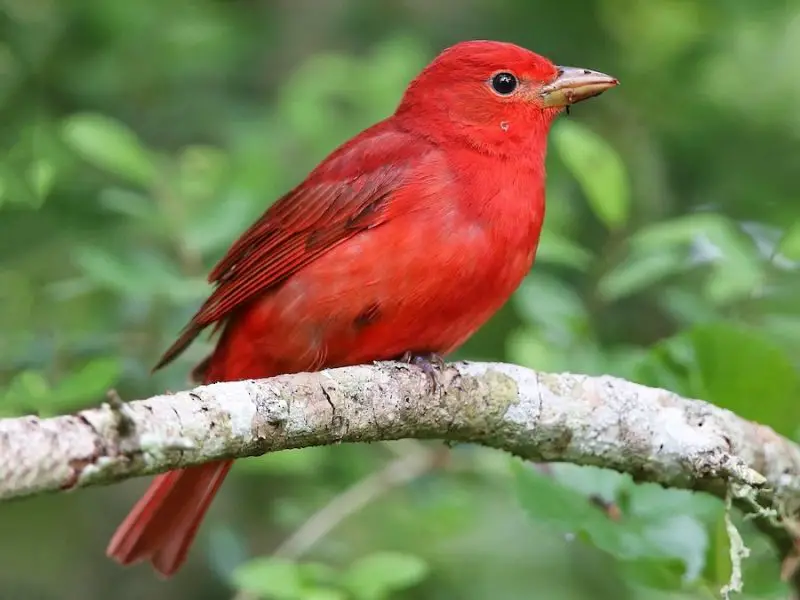
The Summer Tanager is a less common but equally beautiful red bird found in Maryland’s warmer months. Adult males are uniformly rosy red, lacking the contrasting black wings found in Scarlet Tanagers. Females and immature birds are yellowish to orange, making them less conspicuous but still noticeable among leafy woodlands. The Summer Tanager’s solid coloration and robust build distinguish it from other red birds.
This species measures about 7.5 to 8.5 inches (19 to 22 cm) in length with a wingspan close to 12 inches (30 cm). Their song is a series of melodious phrases, often described as a rough but pleasant repetition of whistles and warbles. They use their song to establish territory and attract mates. Summer Tanagers are more often heard than seen because they tend to stay hidden in dense foliage.
Summer Tanagers primarily feed on bees, wasps, and other flying insects, skillfully catching them in mid-air. They are known for their ability to remove stingers from bees before eating them. Besides insects, they consume fruits and berries, especially during migration and in late summer. Their feeding behavior plays an important role in controlling insect populations.
In Maryland, Summer Tanagers are mostly seen in the southern and eastern parts of the state during late spring through early fall. They favor open woodlands, forest edges, and riparian habitats where insect prey is abundant. Summer Tanagers migrate south for the winter, so their presence in Maryland is seasonal but welcomed by bird enthusiasts who appreciate their rich red plumage and unique habits.
House Finch (Haemorhous mexicanus)
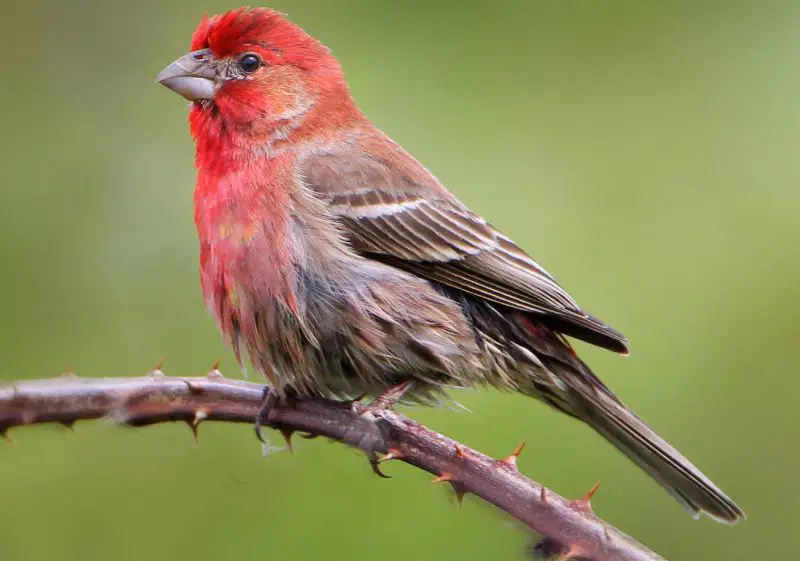
The House Finch is a small songbird with a distinctive splash of red on the male’s forehead, throat, and chest, though the brightness and extent of this red coloration can vary greatly depending on diet, particularly the intake of carotenoid-rich foods. Females lack the red and are mostly brown with streaked underparts, making them more camouflaged and harder to spot. Both sexes have a conical, sturdy beak ideal for seed eating. The House Finch measures about 5 to 6 inches (13 to 15 cm) in length with a wingspan near 8 to 10 inches (20 to 25 cm).
House Finches have a cheerful, warbling song that consists of a rapid series of jumbled notes, sometimes described as a tinkling melody. They are vocal birds, often heard singing from rooftops, wires, and trees. Their calls include a sharp “cheep” or “chirp,” which they use for communication within flocks or as alarms. Males sing throughout the breeding season to attract mates and defend their territory.
Behaviorally, House Finches are highly adaptable and thrive in urban and suburban environments. They are social birds that often gather in flocks, especially outside of the breeding season. Their diet consists mainly of seeds, fruits, and berries, but they also eat buds and flowers. House Finches are frequent visitors to bird feeders, where they readily accept sunflower seeds and other common offerings.
In Maryland, House Finches are abundant year-round residents and can be found throughout the state. Their ability to live close to human habitation makes them a familiar presence in backyards, parks, city streets, and agricultural areas. Because of their adaptability and widespread distribution, House Finches are one of the most common red-tinged birds observed by Maryland birdwatchers.
Purple Finch (Haemorhous purpureus)
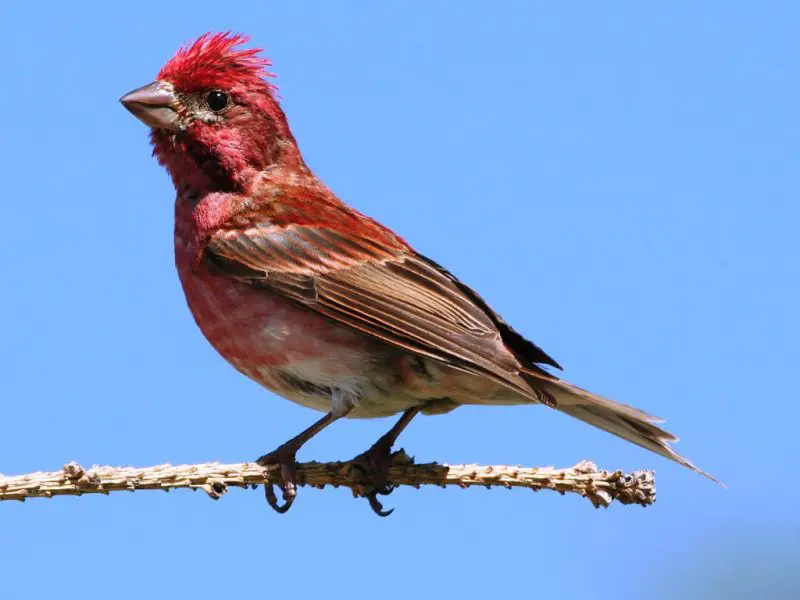
The Purple Finch is a medium-sized finch with males exhibiting a rich raspberry-red coloration on the head, chest, and back, which gives them their name despite the shade being more of a purplish-red. Females are markedly different, sporting a brown, heavily streaked plumage with white underparts and a distinctive white eyebrow stripe, allowing for easy identification. Purple Finches measure roughly 6 to 7 inches (15 to 18 cm) in length with a wingspan of about 10 to 11 inches (25 to 28 cm).
Their song is a pleasant, warbling melody that includes a series of varied and musical phrases, often described as sweeter and more complex than that of House Finches. Purple Finches are somewhat shy and tend to stay high in the tree canopy, where their vocalizations are heard more often than the birds are seen. Their calls include soft chip notes and trills used for communication.
Purple Finches primarily eat seeds, berries, and buds but are also known to consume insects during the breeding season. They are frequent visitors to backyard feeders, especially in winter, where they enjoy sunflower seeds and suet. Their feeding habits play a role in controlling insect populations and dispersing seeds.
In Maryland, Purple Finches are mostly winter visitors, arriving from northern breeding grounds. They can be found in deciduous and mixed woodlands, suburban areas, and near feeders from late fall through early spring. While less common than House Finches, they are treasured by birders for their vibrant colors and delightful songs during the colder months.
Red-headed Woodpecker (Melanerpes erythrocephalus)

The Red-headed Woodpecker is a striking bird easily identified by its completely bright red head, neck, and throat, contrasted with a stark white belly and black back and wings with large white patches. This bold color pattern sets it apart from other woodpecker species. The bird measures about 7.5 to 9 inches (19 to 23 cm) in length with a wingspan of approximately 16 to 18 inches (41 to 46 cm). Its strong bill is well-suited for chiseling wood and catching insects.
This woodpecker’s call is a sharp, rolling “klee-er” or “churr” sound, often repeated loudly. It also drums on dead trees or utility poles to mark territory or attract mates. Red-headed Woodpeckers are agile foragers, known for their habit of caching food such as acorns and insects in tree crevices, bark, or fence posts for later consumption.
Behaviorally, Red-headed Woodpeckers prefer open woodland habitats, including oak savannas, orchards, and forest edges, often near water. They nest in cavities they excavate in dead or decaying trees. Though once more widespread, their numbers have declined due to habitat loss but they remain present in western and southern Maryland, where suitable habitat exists.
In Maryland, this woodpecker is considered uncommon but can be spotted during the breeding season in open forests and parklands. Birders appreciate their vibrant head color and bold behavior, which contrasts with the more subdued woodpeckers. Conservation efforts continue to focus on preserving their habitat to support population recovery.
Red-bellied Woodpecker (Melanerpes carolinus)

Despite its name, the Red-bellied Woodpecker is more famous for the striking red patch that runs from the crown to the nape on males, while females have red only on the nape. The rest of its body is patterned with black-and-white barred wings and a pale belly with a faint reddish tinge. It measures about 9 to 10 inches (23 to 25 cm) in length and has a wingspan of roughly 13 to 16 inches (33 to 41 cm). Its robust bill is perfectly adapted for excavating wood and probing for insects.
The vocalizations of the Red-bellied Woodpecker include loud, rolling calls that sound like “churr” or “kwirr.” They also produce a rapid drum on resonant surfaces to communicate. These woodpeckers are active and often loud birds, easily identified by their distinctive calls even if they are hidden in dense foliage.
This species is an opportunistic feeder, eating insects, fruits, nuts, and seeds. They are known to forage by climbing tree trunks and branches, probing bark for insects, and sometimes catching flying insects mid-air. Red-bellied Woodpeckers also visit bird feeders and will eat suet, sunflower seeds, and peanuts.
Red-bellied Woodpeckers are widespread and common throughout Maryland, inhabiting deciduous forests, woodlots, suburban areas, and parks. Their adaptability to various habitats, including urban settings, makes them one of the most frequently observed woodpeckers in the state year-round.
Best Times and Places to See Red Birds in Maryland
Maryland offers excellent opportunities to observe red birds throughout much of the year, but the best times and places can vary depending on the species. For resident birds like the Northern Cardinal and House Finch, you can enjoy their vibrant presence year-round, especially in suburban backyards, parks, and forest edges where they forage and sing. Spring and early summer are particularly rewarding seasons to see breeding plumages and hear their full range of songs. Migratory red birds such as the Scarlet Tanager and Summer Tanager are most visible during late spring through early fall when they pass through or breed in Maryland’s deciduous forests and woodlands.
Some of the top locations to spot red birds include Maryland’s diverse state parks and natural areas, like Patapsco Valley State Park, Gunpowder Falls State Park, and the forests of western Maryland. These areas provide the mature trees and rich habitats favored by tanagers and woodpeckers. Additionally, suburban and rural areas with bird feeders attract species like House Finches and Purple Finches during fall and winter months. Early mornings and late afternoons, when birds are most active, offer the best chances for sightings and photography.
For woodpeckers such as the Red-headed and Red-bellied Woodpeckers, open woodlands, orchards, and forest edges are ideal habitats throughout the warmer months. Keep an eye out for these striking birds near dead trees or snags where they forage and nest. By visiting a mix of habitats and timing your outings during peak activity hours, bird enthusiasts can maximize their chances of encountering Maryland’s dazzling red birds in all their glory.



